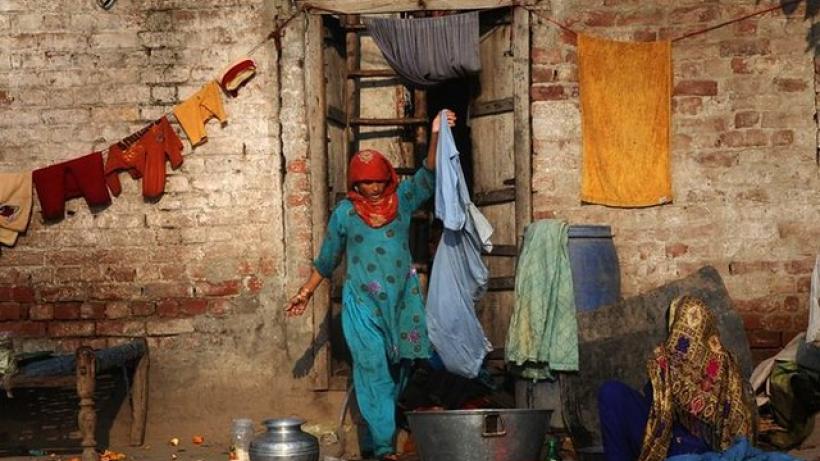
Women’s mobility and labour force participation in Karachi: Some preliminary observations
Pakistan has the lowest female labour-force participation rate in South Asia[1] and urban areas perform especially poorly[2]. Distinct patriarchal norms interlinked with migrant status can affect women’s autonomy and thus labour-force participation in different ways. Recently the Collective for Social Science Research conducted fieldwork for the IGC supported project ‘Women’s agency and mobility in the mega-city of Karachi and their labour-force participation’ at three ethnically purposive sites. Many female respondents mentioned instances, relative to patriarchal norms and structures of their communities, which informed their ability to work in the city. In this blog, we attempt to present a current snapshot of some of the diversity of women’s experiences with regards to labour force participation in relation to their community norms and migrant status in Karachi.
Lyari: Racism rather than gender discrimination
Lyari is considered one of the oldest neighbourhoods in Karachi, and predominantly consists of Baloch and Katchi populations that have long assimilated here. Most young Baloch and Katchi women we interviewed preferred to work and complete their education.[3] Two-thirds of younger women have at least completed intermediate exams and nearly all aspired to hold undergraduate degrees if they did not already. In terms of mobility, our female Balochi respondents within Lyari did not report restrictions on mobility from patriarchal figures in the household or street harassment by strangers to the same degree as in other sites where this study was conducted. One respondent who works as a teacher noted that her community respected her a lot for her job, and that when she is walking to work, men actively move out of her way. The extent of mobility and the relative lack of restrictions described by some of the Balochi women around issues of respectability and safety, strictly in a comparative sense with other localities in Karachi, have been surprising for us to learn. They are indicative of norms improving overtime, in conjunction with length of the migration period.
In terms of hindrance to employment, an issue most women noted was labour-market discrimination pertaining to ethnicity rather than gender. Nearly all of our respondents complained about rampant racism in the rest of the city against Lyari residents and its adverse effects on their employability. Being Baloch in addition to being a Lyari resident compounded the problem more so.
Baldia: Women working considered disgraceful and dishonourable
Baldia was selected as a site because it consists of predominantly Pashtun migrants. For women, earning was considered disgraceful and dishonourable because it implied that the household was running on the woman’s income instead of the man’s and the sense of emasculation is a major cause of disrepute for the men in the community. Despite income issues, prospects of poverty still do not seem to mobilise women or let men from their household to relent and let them work or earn. The only instances women resorted to working were in the face of extreme destitution as a result of the absence of a male patriarchal figure and bread-winner in the household, at the expense of disrepute in the community. Older women also hardly held jobs – not even cleaning jobs in households, unlike the other two sites we investigated. Similarly, in terms of education households frequently stopped their daughter’s education after primary school or once they reached puberty, and cited ‘azaad mahol’ (permissive environment), which points towards future potential constraints to labour-force participation.
Korangi: Income issues drive the type of employment
Korangi was chosen due to the ethnically heterogeneous nature of the community and the prevalence of Urdu-speaking and Sindhi populations in the area.
In terms of employment, similar to Lyari, the long assimilated Urdu-speaking and Sindhi women did low-paying private school teaching jobs. If they had income issues they took up better paying, but far more demanding, company or factory jobs. Working in the nearby garment factories was commonly reported by some of the respondents. Older uneducated women usually took up work as cleaners in other households but this was not considered respectful work by them. In contrast, newer Sindhi migrant women were not allowed to work at all, especially if they were young, due to anxieties pertaining to the strangeness of the new and unfamiliar city.
Conclusion: Context specificity is crucial
There is indication that patriarchal arrangements relative to migrant status and cultural notions of respectability, determine the extent of women’s participation in the labour market. The relegation of women’s labour force participation only to certain acceptable occupations or by keeping women at home entirely, unquestioningly indicate that gender norms play a role in shaping women’s labour force participation in Pakistan. In an urban context, mobility is complicated by distinct norms pertaining to patriarchy within their communities, geographic and spatial anxieties due to migrant status, and histories of conflict within the city. Our preliminary findings suggest a differentiated employment strategy concerning women’s labour-force participation, underpinned by social-policy that is context-specific to communities within Karachi is needed.
References
Chaudhary, R and S Verick (2014), “Female labour force participation in India and beyond”, ILO Asia-Pacific Working Paper Series: International Labour Organisation.
(ILO 2014)
Labour Force Survey 2014-15. (2015): Pakistan Bureau of Statistics.
Quarterly Labour Force Survey 2015-16. (2017): Bangladesh Bureau of Statistics.
[1] 57% in Bangladesh (ILO 2014), 29% in India (ILO 2014), and 22% in Pakistan (PLFPS 2015).
[2] 10% for urban areas in Pakistan in 2015 (PLFPS 2015), as compared to 15.5% for urban areas in India in 2011 (ILO 2014), and 14.7% for Bangladesh in 2016 (QLFS 2017).
[3] The jobs many women hold are low-paying teaching jobs at local private schools because they are a walking distance from their homes, which indicates that many young women do struggle with family restrictions on their mobility

